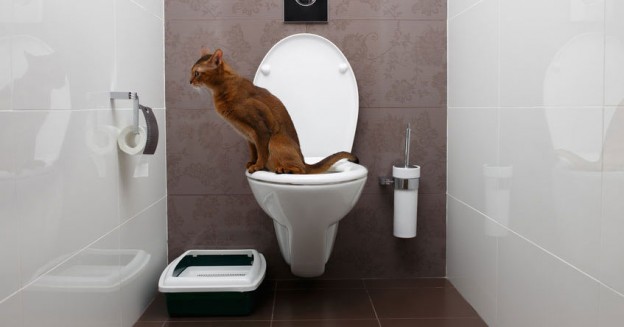Dangers of Flushing Cat Poop in Your Toilet - Precautionary Steps
Dangers of Flushing Cat Poop in Your Toilet - Precautionary Steps
Blog Article
Almost everyone has got their personal opinion with regards to Don’t flush cat feces down the toilet.

Intro
As feline owners, it's essential to bear in mind exactly how we dispose of our feline close friends' waste. While it might seem hassle-free to flush cat poop down the commode, this practice can have destructive repercussions for both the environment and human wellness.
Alternatives to Flushing
Luckily, there are much safer and more liable methods to deal with pet cat poop. Think about the complying with alternatives:
1. Scoop and Dispose in Trash
One of the most typical technique of getting rid of pet cat poop is to scoop it into a biodegradable bag and toss it in the trash. Make certain to use a committed litter inside story and deal with the waste without delay.
2. Use Biodegradable Litter
Go with eco-friendly feline clutter made from materials such as corn or wheat. These trashes are eco-friendly and can be safely thrown away in the trash.
3. Bury in the Yard
If you have a backyard, consider burying pet cat waste in an assigned location away from vegetable gardens and water resources. Make certain to dig deep enough to avoid contamination of groundwater.
4. Mount a Pet Waste Disposal System
Invest in an animal garbage disposal system specifically designed for cat waste. These systems utilize enzymes to break down the waste, lowering smell and environmental effect.
Health and wellness Risks
Along with ecological concerns, flushing feline waste can additionally position health and wellness threats to humans. Cat feces may include Toxoplasma gondii, a bloodsucker that can create toxoplasmosis-- a possibly extreme illness, specifically for pregnant ladies and individuals with damaged body immune systems.
Environmental Impact
Purging cat poop introduces dangerous virus and bloodsuckers into the water system, posturing a substantial threat to aquatic communities. These pollutants can adversely influence marine life and compromise water high quality.
Verdict
Liable pet dog possession prolongs beyond offering food and shelter-- it also involves proper waste management. By refraining from purging pet cat poop down the commode and selecting different disposal approaches, we can decrease our ecological impact and secure human health and wellness.
Why Can’t I Flush Cat Poop?
It Spreads a Parasite
Cats are frequently infected with a parasite called toxoplasma gondii. The parasite causes an infection called toxoplasmosis. It is usually harmless to cats. The parasite only uses cat poop as a host for its eggs. Otherwise, the cat’s immune system usually keeps the infection at low enough levels to maintain its own health. But it does not stop the develop of eggs. These eggs are tiny and surprisingly tough. They may survive for a year before they begin to grow. But that’s the problem.
Our wastewater system is not designed to deal with toxoplasmosis eggs. Instead, most eggs will flush from your toilet into sewers and wastewater management plants. After the sewage is treated for many other harmful things in it, it is typically released into local rivers, lakes, or oceans. Here, the toxoplasmosis eggs can find new hosts, including starfish, crabs, otters, and many other wildlife. For many, this is a significant risk to their health. Toxoplasmosis can also end up infecting water sources that are important for agriculture, which means our deer, pigs, and sheep can get infected too.
Is There Risk to Humans?
There can be a risk to human life from flushing cat poop down the toilet. If you do so, the parasites from your cat’s poop can end up in shellfish, game animals, or livestock. If this meat is then served raw or undercooked, the people who eat it can get sick.
In fact, according to the CDC, 40 million people in the United States are infected with toxoplasma gondii. They get it from exposure to infected seafood, or from some kind of cat poop contamination, like drinking from a stream that is contaminated or touching anything that has come into contact with cat poop. That includes just cleaning a cat litter box.
Most people who get infected with these parasites will not develop any symptoms. However, for pregnant women or for those with compromised immune systems, the parasite can cause severe health problems.
How to Handle Cat Poop
The best way to handle cat poop is actually to clean the box more often. The eggs that the parasite sheds will not become active until one to five days after the cat poops. That means that if you clean daily, you’re much less likely to come into direct contact with infectious eggs.
That said, always dispose of cat poop in the garbage and not down the toilet. Wash your hands before and after you clean the litter box, and bring the bag of poop right outside to your garbage bins.
https://trenchlesssolutionsusa.com/why-cant-i-flush-cat-poop/

I am just very inquisitive about How to Dispose of Cat Poop and Litter Without Plastic Bags and I am hoping you liked our post. Enjoyed reading our piece of writing? Please share it. Help others check it out. Thanks for your time spent reading it.
Book An Estimate Now Report this page